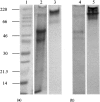The inhibition of the Human Immunodeficiency Virus type 1 activity by crude and purified human pregnancy plug mucus and mucins in an inhibition assay
- PMID: 18489743
- PMCID: PMC2409310
- DOI: 10.1186/1743-422X-5-59
The inhibition of the Human Immunodeficiency Virus type 1 activity by crude and purified human pregnancy plug mucus and mucins in an inhibition assay
Abstract
Background: The female reproductive tract is amongst the main routes for Human Immunodeficiency Virus (HIV) transmission. Cervical mucus however is known to protect the female reproductive tract from bacterial invasion and fluid loss and regulates and facilitates sperm transport to the upper reproductive tract. The purpose of this study was to purify and characterize pregnancy plug mucins and determine their anti-HIV-1 activity in an HIV inhibition assay.
Methods: Pregnancy plug mucins were purified by caesium chloride density-gradient ultra-centrifugation and characterized by Western blotting analysis. The anti-HIV-1 activities of the crude pregnancy plug mucus and purified pregnancy plug mucins was determined by incubating them with HIV-1 prior to infection of the human T lymphoblastoid cell line (CEM SS cells).
Results: The pregnancy plug mucus had MUC1, MUC2, MUC5AC and MUC5B. The HIV inhibition assay revealed that while the purified pregnancy plug mucins inhibit HIV-1 activity by approximately 97.5%, the crude pregnancy plug mucus failed to inhibit HIV-1 activity.
Conclusion: Although it is not clear why the crude sample did not inhibit HIV-1 activity, it may be that the amount of mucins in the crude pregnancy plug mucus (which contains water, mucins, lipids, nucleic acids, lactoferrin, lysozyme, immunoglobulins and ions), is insufficient to cause viral inhibition or aggregation.
Figures




Similar articles
-
Mucus and Mucins: do they have a role in the inhibition of the human immunodeficiency virus?Virol J. 2017 Oct 6;14(1):192. doi: 10.1186/s12985-017-0855-9. Virol J. 2017. PMID: 28985745 Free PMC article. Review.
-
The role of crude human saliva and purified salivary MUC5B and MUC7 mucins in the inhibition of Human Immunodeficiency Virus type 1 in an inhibition assay.Virol J. 2006 Nov 24;3:99. doi: 10.1186/1743-422X-3-99. Virol J. 2006. PMID: 17125499 Free PMC article.
-
The role of crude saliva and purified salivary mucins in the inhibition of the Human Immunodeficiency Virus type 1.Virol J. 2012 Aug 28;9:177. doi: 10.1186/1743-422X-9-177. Virol J. 2012. PMID: 22929306 Free PMC article.
-
The cervical mucus plug: structured review of the literature.Acta Obstet Gynecol Scand. 2009;88(5):502-13. doi: 10.1080/00016340902852898. Acta Obstet Gynecol Scand. 2009. PMID: 19330570 Review.
-
Anti-HIV-1 activity of salivary MUC5B and MUC7 mucins from HIV patients with different CD4 counts.Virol J. 2010 Oct 14;7:269. doi: 10.1186/1743-422X-7-269. Virol J. 2010. PMID: 20946627 Free PMC article.
Cited by
-
Breastfeeding Behaviors and the Innate Immune System of Human Milk: Working Together to Protect Infants against Inflammation, HIV-1, and Other Infections.Front Immunol. 2017 Nov 29;8:1631. doi: 10.3389/fimmu.2017.01631. eCollection 2017. Front Immunol. 2017. PMID: 29238342 Free PMC article. Review.
-
Human Metapneumovirus Induces Mucin 19 Which Contributes to Viral Pathogenesis.Pathogens. 2020 Sep 3;9(9):726. doi: 10.3390/pathogens9090726. Pathogens. 2020. PMID: 32899224 Free PMC article.
-
Stone age diseases and modern AIDS.Virol J. 2008 Aug 7;5:93. doi: 10.1186/1743-422X-5-93. Virol J. 2008. PMID: 18687115 Free PMC article.
-
Mucus and Mucins: do they have a role in the inhibition of the human immunodeficiency virus?Virol J. 2017 Oct 6;14(1):192. doi: 10.1186/s12985-017-0855-9. Virol J. 2017. PMID: 28985745 Free PMC article. Review.
-
Acute chorioamnionitis and funisitis: definition, pathologic features, and clinical significance.Am J Obstet Gynecol. 2015 Oct;213(4 Suppl):S29-52. doi: 10.1016/j.ajog.2015.08.040. Am J Obstet Gynecol. 2015. PMID: 26428501 Free PMC article. Review.
References
-
- Carlstedt I, Sheehan J, Ulmsten U, Wingerup L. Isolation and purification of the mucin component of human cervical mucus. Adv Exp Med Biol. 1982;144:273–275. - PubMed
Publication types
MeSH terms
Substances
LinkOut - more resources
Full Text Sources
Research Materials
Miscellaneous

